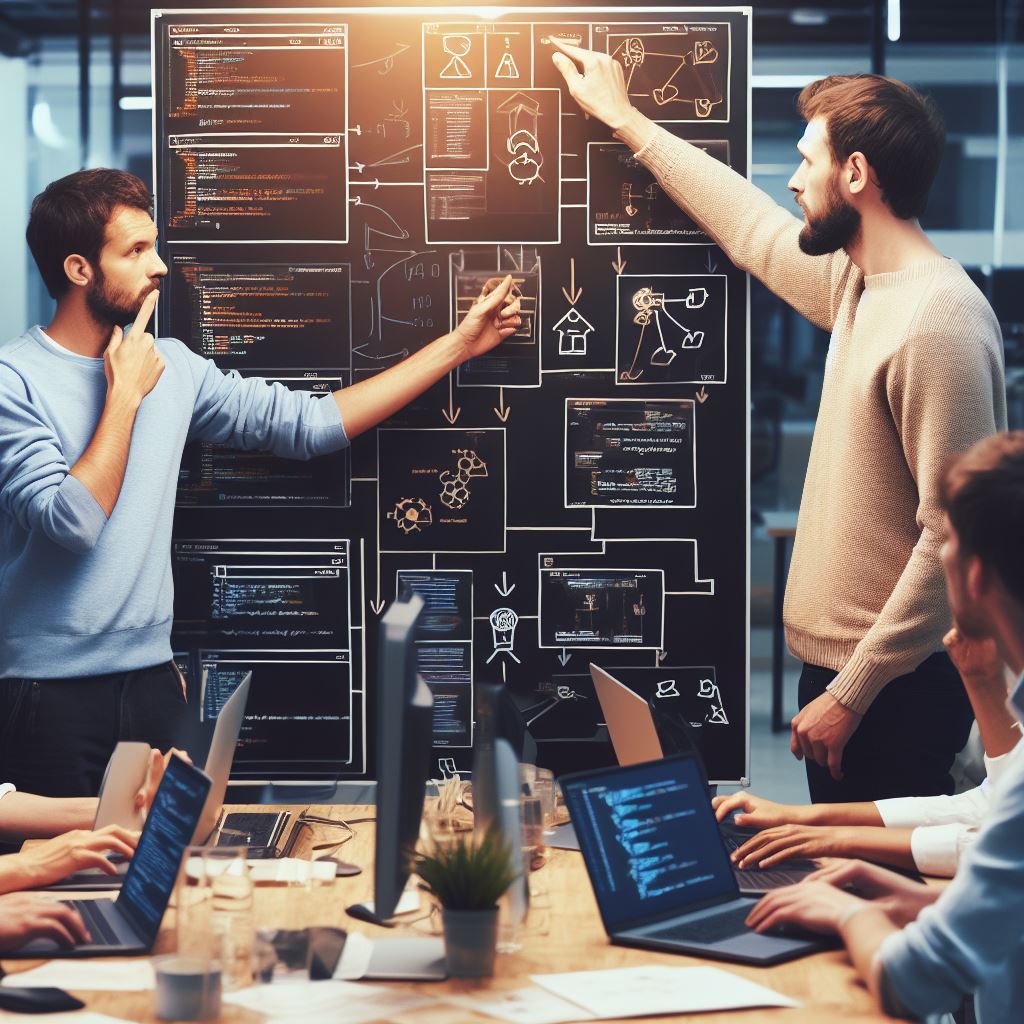Node-Webkit is a powerful tool that allows developers to create desktop applications using HTML, CSS, and JavaScript.
It combines Chromium and Node.js into a single runtime environment.
By using Node-Webkit, developers can leverage their existing skills in web development to build feature-rich media players.
They can utilize their knowledge of HTML, CSS, and JavaScript to create user-friendly interfaces and implement multimedia functionalities.
One of the key advantages of using Node-Webkit for creating a media player is its ability to access operating systems’ native APIs.
This allows developers to interact with the file system, control audio and video playback, and handle system events.
With these capabilities, developers can create media players that seamlessly integrate with the user’s operating system and provide a native application experience.
Another advantage is the flexibility Node-Webkit offers in terms of packaging and distribution.
Developers can bundle their media player application with the Node-Webkit runtime, which means users don’t need to install any additional software.
This simplifies the deployment process and allows users to easily install and run the media player on their systems.
In addition, Node-Webkit provides a rich set of APIs and libraries that simplify media-related tasks.
Developers can use libraries like FFmpeg to handle video and audio encoding/decoding, or utilize frameworks like React or Angular to build complex user interfaces.
Node-Webkit is a versatile platform for creating media players that leverage web technologies.
It provides access to native APIs, simplifies packaging and distribution, and offers a range of APIs and libraries for media-related tasks.
With these advantages, developers can build powerful and customized media players to meet their users’ needs.
Tech Consulting Tailored to Your Coding Journey
Get expert guidance in coding with a personalized consultation. Receive unique, actionable insights delivered in 1-3 business days.
Get StartedSetting up the development environment
Setting up the development environment for creating a media player using Node-Webkit involves several steps. Here is a detailed guide on how to get started:
1. Installing Node.js:
- Download the latest version of Node.js from the official website.
- Follow the installation instructions specific to your operating system.
- Verify the installation by opening a command prompt and typing “node -v”. It should display the installed version.
2. Installing Node-Webkit:
- Open a command prompt and navigate to your project folder.
- Use npm (Node Package Manager) to install Node-Webkit globally by running the command “npm install -g nodewebkit”.
- This will install Node-Webkit globally, making it accessible from anywhere on your machine.
3. Configuring the project structure:
- Create a new folder for your media player project.
- Inside the project folder, create subfolders for different components such as “src” for source code, “assets” for media files, etc.
- Create a package.json file in the project root folder. This file will contain metadata about your project and its dependencies.
- Add the necessary dependencies to the package.json file, such as “nodewebkit” and any other libraries you plan to use.
Sample package.json:
{
"name": "media-player",
"version": "1.0.0",
"main": "src/index.html",
"scripts": {
"start": "nodewebkit"
},
"devDependencies": {
"nodewebkit": "^0.28.4"
}
}
4. Creating the main entry file:
- Inside the “src” folder, create an “index.html” file that will serve as the entry point for your media player.
- Add the necessary HTML structure, including tags for player controls, media playback area, etc.
- Link the required CSS and JavaScript files using the appropriate tags.
Sample index.html:
<!DOCTYPE html>
<html>
<head>
<meta charset="UTF-8"><br> <link rel="stylesheet" href="styles.css">
<title>Media Player</title>
</head>
<body>
<div id="player-controls">
<!-- Add player controls here -->
</div>
<div id="media-container">
<!-- Add media playback area here -->
</div>
<script src="main.js"></script>
</body>
</html>5. Coding the media player functionality:
- Inside the “src” folder, create a “main.js” file to write the JavaScript logic for your media player.
- Use Node.js modules and APIs to handle user interactions, media playback, etc.
- Implement the desired functionality, such as play, pause, stop, volume control, playlist management, etc.
Sample main.js:
// Add your media player logic here
const playButton = document.getElementById("play-button");
const videoPlayer = document.getElementById("video-player");
playButton.addEventListener("click", () => {
if (videoPlayer.paused) {
videoPlayer.play();
playButton.innerText = "Pause";
} else {
videoPlayer.pause();
playButton.innerText = "Play";
}
});6. Running the media player:
- Open a command prompt and navigate to your project folder.
- Run the command “npm start” to start the Node-Webkit application.
- You should see the media player window open up with your HTML and CSS rendering correctly.
Setting up the development environment for creating a media player using Node-Webkit involves installing Node.js, configuring the project structure, and coding the player’s functionality.
With these steps, you can start building your own media player and customize it to your specific needs.
Read: The Impact of Color Schemes in Coding Wallpapers
Creating a Media Player Using Node-Webkit: Step-by-Step
In this section, we will discuss how to create a media player using Node-Webkit.
Creating the user interface:
- Start by designing the main window of the media player.
- Consider the layout and placement of different components in the window.
- Use a combination of HTML and CSS to create the desired user interface.
- Add buttons and other controls to provide functionalities such as play, pause, and volume control.
- Ensure that all controls are responsive and user-friendly.
Designing the main window:
- Determine the size and shape of the media player window.
- Consider the aspect ratio and resolution to ensure optimal viewing experience.
- Include a video player component to display the media content.
- Choose an appropriate background color or image to enhance the aesthetics.
Adding buttons and other controls:
- Include a play button to start or resume playback of media content.
- Incorporate a pause button to temporarily halt the playback.
- Implement buttons to adjust volume levels and mute the audio.
- Include a seek bar to allow users to navigate within the media content.
- Add a full-screen button for an immersive viewing experience.
- Include buttons for navigating between different media files.
Styling the interface using CSS:
- Use CSS to define the font, color, and size of text displayed in the media player.
- Customize the appearance of buttons and controls to match the overall theme.
- Apply transitions and animations to create smooth visual effects.
- Ensure the interface is visually appealing and easy to navigate.
- Test the media player on different devices and screen sizes to ensure responsiveness.
Creating a media player using Node-Webkit is an exciting project that requires careful design and implementation.
By following the steps outlined in this section, you can build a functional and visually appealing media player.
Remember to consider the user interface, design the main window, add buttons and controls, and style the interface using CSS.
With these steps, you can create a media player that provides a seamless and enjoyable media playback experience.
Read: CodeIgniter vs Laravel: Which PHP Framework to Choose?
Handling user input and events
Handling user input and events is an essential aspect of creating a media player using Node-Webkit.
Build Your Vision, Perfectly Tailored
Get a custom-built website or application that matches your vision and needs. Stand out from the crowd with a solution designed just for you—professional, scalable, and seamless.
Get StartedIt allows users to interact with the player and control various functionalities. In this section, we will discuss how to detect button clicks, play and pause media, and control volume and seeking.
Detecting button clicks
Firstly, let’s focus on detecting button clicks. We can achieve this by using event listeners.
By attaching an event listener to a button element, we can execute a specific function when the button is clicked. This enables us to trigger actions like playing a media file or pausing it.
Playing and pausing media
Next, playing and pausing media is crucial for providing users with control over the playback. To accomplish this, we can utilize the HTML5 audio or video element.
By accessing the respective element and using its built-in methods like play() and pause(), we can start or stop media playback as per the user’s command.
Volume control and seeking
Additionally, volume control is an essential feature of any media player.
By implementing a range input element, we can allow users to adjust the volume level interactively. We can use the input event to listen for changes in the range input’s value and update the media player’s volume accordingly.
Moreover, seeking allows users to jump to a specific position in the media file.
We can implement this functionality by using another range input element that represents the current playback position. By listening to the input event on this range input, we can update the media player’s current time, effectively seeking to the desired position.
To ensure smooth and responsive user interactions, it is necessary to handle these user inputs and events efficiently. We can achieve this by using event delegation.
Instead of attaching event listeners to each individual button or input element, we can attach a single event listener to the parent container and utilize event bubbling to handle the events.
Furthermore, it is essential to provide user feedback when buttons are clicked or media playback is triggered.
We can achieve this by manipulating the CSS class of the respective elements. By adding or removing specific classes, we can animate buttons or display a visual cue to indicate media playback status.
Handling user input and events is crucial to creating an interactive media player using Node-Webkit.
Optimize Your Profile, Get Noticed
Make your resume and LinkedIn stand out to employers with a profile that highlights your technical skills and project experience. Elevate your career with a polished and professional presence.
Get NoticedBy detecting button clicks, playing and pausing media, controlling volume, and seeking, we can provide users with the necessary control and functionality they expect from a media player application.
Implementing these features and efficiently handling user interactions will enhance the overall user experience and make our media player stand out.
Read: Coding Blocks in Go: Writing More Efficient Code
Implementing the media functionality
Now that we have implemented the basic functionality of our media player, it’s time to focus on enhancing the media features. In this section, we will cover the following aspects of the media player using Node-Webkit.
1. Choosing a media playback library:
When it comes to playing media files, there are several libraries available for Node-Webkit. One popular choice is the HTML5 audio and video element. It provides native support for media playback and is compatible with most modern browsers. Another option is the Howler.js library, which offers more advanced features like audio sprite support and audio visualization.
2. Initializing the media player:
To begin, we need to initialize the media player by creating a new instance of the chosen media library. This step involves setting up any required options or configurations for the library.
3. Loading and playing media files:
Once the media player is initialized, we can load media files into it for playback. This can be done by passing the file path or URL to the media library’s API. After loading the media file, we can start playing it using the play() method provided by the library.
4. Displaying media information:
To provide a better user experience, we should display relevant information about the currently playing media. This information may include the title, duration, artist, album, etc. We can retrieve this information from the media library’s API and display it in the user interface.
By implementing these features, we can significantly improve the media functionality of our Node-Webkit media player. Let’s go through the implementation steps in more detail.
First, we need to choose a media playback library that suits our requirements. We can conduct some research and compare the features and performance of different libraries before making a decision.
We can also consider factors like community support and ease of integration with Node-Webkit.
Once we have chosen a library, we can proceed with initializing the media player. This involves creating a new instance of the library and setting up any required options or configurations. For example, if we are using the HTML5 audio and video element, we might need to specify the audio or video format that our media files will be in.
Next, we need to implement the logic for loading and playing media files. This can be done by adding event listeners to the necessary elements in our user interface. When a user selects a media file, we can extract the file path or URL and pass it to the media library’s API for loading and playback.
Finally, we can enhance the user experience by displaying relevant media information. This information can be retrieved from the media library’s API using methods like getTitle(), getDuration(), getArtist(), etc. We can then update the user interface to reflect this information.
Implementing the media functionality of our Node-Webkit media player involves choosing a media playback library, initializing the player, loading and playing media files, and displaying relevant media information.
By following these steps, we can create a fully functional media player that provides an immersive user experience.
Read: Understanding Asynchronous Coding Blocks in Node.js
Testing and debugging the media player
Creating a Media Player Using Node-Webkit: Step-by-Step
1. Using Developer Tools for Debugging:
- Open the developer tools in Node-Webkit by right-clicking and selecting “Inspect Element”.
- Debug JavaScript code using breakpoints, stepping through code, and inspecting variables.
- Utilize the console to log messages and view errors during the testing phase.
2. Testing Different Media Formats and Codecs:
- Ensure the media player supports various formats like MP3, MP4, AVI, and MOV.
- Test different codecs to make sure the player can handle diverse encoding methods.
- Verify the media player’s compatibility with popular formats used by different platforms.
3. Handling Errors and Exceptions:
- Implement error handling mechanisms to gracefully handle unexpected errors.
- Use try/catch blocks to catch and handle exceptions, preventing the application from crashing.
- Display informative error messages to guide users in troubleshooting any encountered issues.
Testing and debugging the media player is a crucial step in its development process.
By employing developer tools for debugging, one can efficiently identify and fix any issues present in the code.
Furthermore, it is essential to test the player with various media formats and codecs to ensure its versatility and compatibility across different platforms.
Using developer tools is a common practice during the testing phase. By opening the developer tools in Node-Webkit and inspecting elements, developers can easily analyze and debug JavaScript code.
Through the use of breakpoints and step-by-step code execution, it becomes simpler to pinpoint problematic code sections and identify their causes.
Moreover, developers can utilize the console to log messages and monitor errors, providing insights into potential issues and aiding the debugging process.
When testing a media player, it is crucial to validate its compatibility with different media formats and codecs. Media consumption today spans across a multitude of formats, including MP3, MP4, AVI, and MOV.
Ensuring that the player supports such formats guarantees a seamless user experience. Additionally, testing the player with various codecs is vital as different encodings can affect the player’s ability to decode and render media accurately.
Conducting comprehensive tests allows developers to address any compatibility issues and make necessary adjustments.
Errors and exceptions can occur unexpectedly during the usage of a media player. Implementing error handling mechanisms is crucial to maintain the stability and usability of the application.
By using try/catch blocks, developers can catch and manage exceptions effectively, preventing the application from crashing.
Adequate error messages should also be displayed to guide users in troubleshooting potential issues and facilitating a smoother user experience.
Testing and debugging are essential aspects of creating a media player using Node-Webkit.
By employing developer tools, testing different media formats and codecs, and implementing error handling mechanisms, developers can ensure the quality and functionality of the final product.
Testing encompasses the validation of compatibility with various formats and codecs to provide a seamless experience.
Debugging, on the other hand, allows for the identification and fixing of any issue or error encountered during the development process.
Overall, these steps contribute to the success of the media player and enhance user satisfaction.

Creating a Media Player Using Node-Webkit: Step-by-Step
Packaging and distributing the media player:
1. Building the executable file:
To package our media player, we need to create an executable file that users can easily run.
2. Including necessary dependencies:
We must ensure that all the required dependencies are included in our package for proper functionality.
3. Creating installation packages for different platforms:
To reach a wider audience, we should create installation packages specifically tailored for different platforms.
Building the executable file:
To build the executable file, we need to follow these steps:
1. Set up the Node-Webkit project:
Begin by setting up a new project using the Node-Webkit framework, providing a suitable project name.
2. Create the main app file:
Develop the main application file where the media player’s functionality will be implemented. This file will be the entry point of our application.
3. Define the required dependencies:
Ensure that all the necessary dependencies like MP3 or MP4 codecs, media controls, and player UI components are included and properly linked within the application.
4. Implement media playback:
Utilize suitable libraries or modules to enable media playback within our application, allowing users to easily play their desired media files.
5. Design the user interface:
Create an intuitive and user-friendly interface using HTML, CSS, and JavaScript to enhance the overall user experience.
6. Test and debug the application:
Thoroughly test the media player application to identify any bugs or glitches that may hinder its performance.
7. Create the executable file:
Use appropriate tools or build scripts to compile the application into an executable file that users can launch on their systems.
Including necessary dependencies:
To ensure all dependencies are included with our media player, we should:
1. Identify required dependencies:
Determine the specific dependencies needed for our media player, such as audio or video codecs, media control libraries, or player UI components.
2. Download and install dependencies:
Locate and download the required dependencies from reliable sources. Follow the installation instructions provided by the developers.
3. Link dependencies with the application:
Integrate the downloaded dependencies into our media player project, ensuring they are properly linked and accessible within the application code.
4. Verify proper functionality:
Test the media player thoroughly to ensure all dependencies are functioning correctly and the desired features are operational.
Creating installation packages for different platforms:
To distribute the media player to different platforms, follow these steps:
1. Determine target platforms:
Identify the platforms for which we want to create installation packages, such as Windows, macOS, or Linux.
2. Research platform-specific requirements:
Research the specific requirements and guidelines for packaging applications on each target platform. This might include file formats, package managers, or signing processes.
3. Install platform-specific tools:
Install the necessary tools and libraries for packaging applications on the target platforms. These can include package managers, build tools, or platform-specific SDKs.
4. Generate platform-specific installation packages:
Utilize the tools and libraries we installed to generate installation packages specific to each platform. This can include .exe, .dmg, or .deb files.
5. Test and validate installation packages:
Verify that the installation packages work correctly on their respective platforms by thoroughly testing them on multiple systems.
By following these steps, we can successfully package and distribute our media player to a wide range of platforms.
Conclusion and Further Improvements
In conclusion, creating a media player using Node-Webkit can be a rewarding experience. By following the step-by-step guide outlined in this blog post, you can successfully build your own media player.
To recap, the steps involved in creating a media player with Node-Webkit are as follows:
- Setting up the project and installing Node-Webkit.
- Creating the user interface using HTML, CSS, and JavaScript.
- Implementing the core functionality such as playing, pausing, and seeking media.
- Enhancing the media player with additional features like volume control and playlist management.
However, there are always possibilities for further improvements and enhancements. Some suggestions include:
- Adding support for different media formats or streaming protocols.
- Implementing additional playback controls such as shuffle, repeat, and fast-forward.
- Incorporating a search feature to easily find and play specific media files.
- Enhancing the interface with more visual elements, animation, or themes.
The beauty of building a media player with Node-Webkit is that it provides a solid foundation that can be customized to fit your needs.
Feel free to explore and experiment with different features, layouts, and functionalities to create a media player that suits your preferences.
Creating a media player using Node-Webkit is an exciting journey that allows you to exercise your creativity and programming skills.
So go ahead, dive in, and build your own personalized media player. The possibilities are endless!




